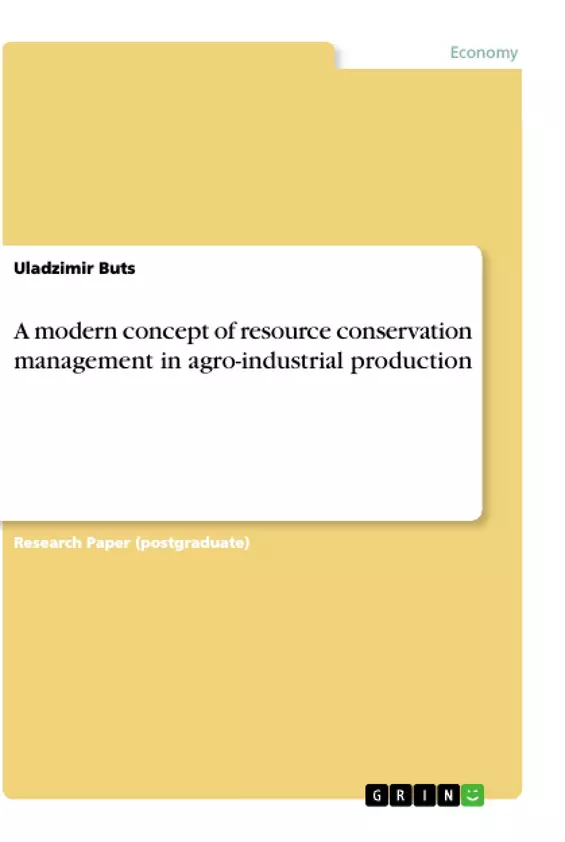The focus of the research presented in this monograph are the processes of saving resources in agro-industrial production. The author proposes a modern concept of resource conservation management. The research methodology was the clustering of economic objects, econometric modeling, optimization of the structure of resource consumption. The focus of the research presented in this monograph is resource conservation processes in agro-industrial production. The author offers a modern concept of resource conservation management. Research methodology: clustering of economic objects, econometric modeling, optimization of the structure of resource consumption. Based on the typology of economic objects, the following classes of resource consumption are proposed: extensive, intensive, innovation and investment. The extensive type of resource conservation is distinguished by the use of economies of scale in agribusiness. The formation of agricultural holdings and the production of food by an agricultural enterprise within the boundaries of the full value chain leads to resource savings through concentration. The intensive type of facilities is characterized by an increase in specific investment per unit of industry size. This is a higher level of chemicalization, mechanization, and robotization of agricultural production. In modern conditions of environmental trends in life and economy, it is replaced by a natural-adaptive type of resource conservation. Among the features of this type, it is necessary to highlight the adaptation of machinery and equipment in agricultural production to the biological properties of agricultural plants and animals. An innovative type of resource saving is innovations in biotechnology, new resource-saving technology and equipment, and agricultural management. The innovative type is added by the investment type. Investments make it possible to ensure a constant increase in the financial flow in agriculture. When the increase in this flow outstrips the increase in costs, there is a significant resource-saving investment effect. The author of the study revealed a pattern between the emergence of the resource-saving effect and the potential for using resources. The resource-saving effect is observed with the full use of the potential of resources. Special attention is paid to human capital. The dynamics of competencies allows to increase the innovativeness of the team in an agricultural organization. The book is understandable for managers.
Inhaltsverzeichnis (Table of Contents)
- INTRODUCTION
- CHAPTER 1. THEORY OF CONTROL RESOURCE
- 1.1 The essence of the categories of resource saving management
- 1.2 Theoretical aspects of the laws and factors of resource saving management in modern conditions
- 1.3 Analysis of resource theory and management of resource-saving
- CHAPTER 2. METHODOLOGICAL ASPECTS CONTROL RESOURCE IN AGRICULTURE PRODUCTION
- 2.1 Methodological approaches to assessing the characteristics of resource use in agricultural production
- 2.2 System principles and methods of resource saving management
- 2.3 Methods for the comparative evaluation of the economic efficiency of consumption and saving resources
- CHAPTER 3. ECONOMIC EVALUATION RESOURCE MANAGEMENT IN AGRICULTURE PRODUCTION
- 3.1 The system of indicators for assessing management effectiveness of resource saving management
- 3.2 Economic analysis of the efficiency of resource saving management results (at the level of regional agriculture)
- 3.3 Toolkit cost analysis of resource
Zielsetzung und Themenschwerpunkte (Objectives and Key Themes)
This work aims to explore the concept of resource saving management, focusing on its application in the context of agricultural production. It examines the theoretical underpinnings, methodological aspects, and economic evaluation of resource management, aiming to contribute to the advancement of sustainable practices in the agricultural sector.
- Theoretical Frameworks of Resource Saving Management
- Methodological Approaches for Assessing Resource Use in Agriculture
- Economic Evaluation of Resource Management Efficiency
- Optimizing Resource Use for Sustainable Agricultural Development
- The Role of Resource Management in Enhancing Competitiveness
Zusammenfassung der Kapitel (Chapter Summaries)
Chapter 1 delves into the theoretical framework of resource saving management, outlining the key categories of resource saving and exploring the laws and factors that influence resource saving management in contemporary settings. The chapter also analyzes resource theory and its application in practical management scenarios.
Chapter 2 explores the methodological aspects of resource management in agricultural production, examining approaches to assess resource use, outlining system principles and methods for resource saving management, and analyzing techniques for comparative evaluation of resource efficiency.
Chapter 3 delves into the economic evaluation of resource management in agriculture. The chapter examines the indicators used to assess management effectiveness of resource saving initiatives, analyzes the economic efficiency of resource saving management results, and explores the toolkit for cost analysis in resource management.
Schlüsselwörter (Keywords)
Resource saving management, agricultural production, economic efficiency, sustainable development, resource theory, methodology, economic evaluation, cost analysis, competitiveness, innovation, regional agriculture, Belarus.
- Quote paper
- Uladzimir Buts (Author), 2016, A modern concept of resource conservation management in agro-industrial production, Munich, GRIN Verlag, https://www.grin.com/document/937728



